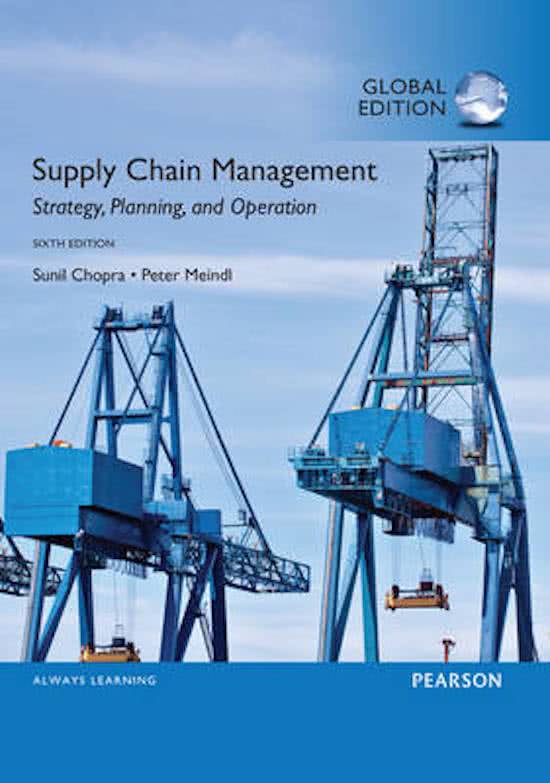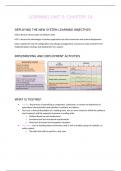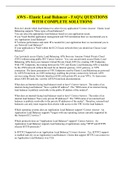E-commerce supply chain management
Week 1
Lecture 1
New development in e-commerce is same day delivery.
- Process orders very quickly.
Retail e-commerce sales growth in in Asia higher than in Europe, because:
- Market share of e-commerce in Europe is quite high.
- Other demographics in Asia.
Business-to-business (B2B) – both sides of the transaction are businesses, non-profit
organizations, or governments.
Business-to-consumer (B2C) – transactions in which buyers are individual consumers.
Consumer-to-consumer (C2C) – consumers sell directly to each other.
Consumer-to-business (C2B) – individuals sell services or goods to businesses.
Company sets up a lot of small tasks and anyone can perform this task.
Amazon Mechanical Turk: anyone could register to perform a task and receive a fee.
Main difference between Alibaba and Amazon?
They’re both large e-commerce players, they are leaders in their markets, both claim that
they are technology firms. But the difference is that Alibaba is only a marketplace, they don’t
own any goods. This difference requires different supply chains.
Supply chain management deals with getting raw materials through a network, transfer
them into products, get these products in the distributers/resellers and in the end get the
products to the customer.
,What is a supply chain?
- All processes involved with the flow of products and services from/to:
o Raw material producers.
o Intermediate product manufacturers.
o End product manufacturers.
o Wholesalers and distributors.
o Retailers.
- Main drivers: transportation, storage and facilities.
- Integration drivers: information, sourcing, pricing.
- Goal: achieve high service levels at low cost.
Service level: ease of use, quality of the service.
Analytical part (definition): for a specific time period, could we deliver to demand or not?
Fill rate = if we have demand of 100 items, how many items of these do we actually meet?
Supply chain deals with:
- Product flows: raw materials to finished products.
- Reverse product flow: returns for repair, replacements, recycling, disposals.
- Information flow: invoices, specifications, receipts, orders, rules & regulations,
forecasts.
- Primary cash flow: payment of products.
Supply chain management definitions:
“The design and management of seamless, value-added processes across organizational
boundaries to meet the real needs of the end customer.”
“Managing supply and demand, sourcing of raw materials and parts, manufacturing and
assembly, warehousing and inventory tracking, order entry and order management,
distribution across all channels, and delivery to the customer.”
“Processes transforming raw materials into end products and getting them to the final
customers. Deals with four flows: product flow, reverse product flow, information flow,
primary cash flow.” – this definition was given by the teacher, definition of SCM must
contain all of these elements.
E-commerce supply chains:
- Manufacturer ships directly to customer, e.g. Babboo.
- E-tailers.
- Marketplace.
- 3PL = third party logistics provider, e.g. PostNL.
Logistics is not the same as supply chain.
Logistics deals with the transportation of goods.
, Supply chain management is much wider.
Forward flows:
- Delivery costs.
- Delivery location.
- Time windows.
Return flows:
- Return costs.
- Return options.
o Drop off locations: drop off at AH or pick up at home.
o Time to return: how long do you have to return.
- Return requirements.
o Packaging: in what packaging does it have to be returned, labelling.
o Ease of return.
RMA – return merchandise authorization.
Process online when you say you want to return certain items, not
fully authorized until the product has arrived in the warehouse.
Which factors are important that influence the likelihood of a person purchasing an item.
All of these three elements should be supported by your supply chain network:
Integrated fulfilment: building e-fulfilment capability into existing distribution centres that
also deliver to conventional stores.
Dedicated fulfilment: via purpose-built “green-field” operations.
Week 1
Lecture 1
New development in e-commerce is same day delivery.
- Process orders very quickly.
Retail e-commerce sales growth in in Asia higher than in Europe, because:
- Market share of e-commerce in Europe is quite high.
- Other demographics in Asia.
Business-to-business (B2B) – both sides of the transaction are businesses, non-profit
organizations, or governments.
Business-to-consumer (B2C) – transactions in which buyers are individual consumers.
Consumer-to-consumer (C2C) – consumers sell directly to each other.
Consumer-to-business (C2B) – individuals sell services or goods to businesses.
Company sets up a lot of small tasks and anyone can perform this task.
Amazon Mechanical Turk: anyone could register to perform a task and receive a fee.
Main difference between Alibaba and Amazon?
They’re both large e-commerce players, they are leaders in their markets, both claim that
they are technology firms. But the difference is that Alibaba is only a marketplace, they don’t
own any goods. This difference requires different supply chains.
Supply chain management deals with getting raw materials through a network, transfer
them into products, get these products in the distributers/resellers and in the end get the
products to the customer.
,What is a supply chain?
- All processes involved with the flow of products and services from/to:
o Raw material producers.
o Intermediate product manufacturers.
o End product manufacturers.
o Wholesalers and distributors.
o Retailers.
- Main drivers: transportation, storage and facilities.
- Integration drivers: information, sourcing, pricing.
- Goal: achieve high service levels at low cost.
Service level: ease of use, quality of the service.
Analytical part (definition): for a specific time period, could we deliver to demand or not?
Fill rate = if we have demand of 100 items, how many items of these do we actually meet?
Supply chain deals with:
- Product flows: raw materials to finished products.
- Reverse product flow: returns for repair, replacements, recycling, disposals.
- Information flow: invoices, specifications, receipts, orders, rules & regulations,
forecasts.
- Primary cash flow: payment of products.
Supply chain management definitions:
“The design and management of seamless, value-added processes across organizational
boundaries to meet the real needs of the end customer.”
“Managing supply and demand, sourcing of raw materials and parts, manufacturing and
assembly, warehousing and inventory tracking, order entry and order management,
distribution across all channels, and delivery to the customer.”
“Processes transforming raw materials into end products and getting them to the final
customers. Deals with four flows: product flow, reverse product flow, information flow,
primary cash flow.” – this definition was given by the teacher, definition of SCM must
contain all of these elements.
E-commerce supply chains:
- Manufacturer ships directly to customer, e.g. Babboo.
- E-tailers.
- Marketplace.
- 3PL = third party logistics provider, e.g. PostNL.
Logistics is not the same as supply chain.
Logistics deals with the transportation of goods.
, Supply chain management is much wider.
Forward flows:
- Delivery costs.
- Delivery location.
- Time windows.
Return flows:
- Return costs.
- Return options.
o Drop off locations: drop off at AH or pick up at home.
o Time to return: how long do you have to return.
- Return requirements.
o Packaging: in what packaging does it have to be returned, labelling.
o Ease of return.
RMA – return merchandise authorization.
Process online when you say you want to return certain items, not
fully authorized until the product has arrived in the warehouse.
Which factors are important that influence the likelihood of a person purchasing an item.
All of these three elements should be supported by your supply chain network:
Integrated fulfilment: building e-fulfilment capability into existing distribution centres that
also deliver to conventional stores.
Dedicated fulfilment: via purpose-built “green-field” operations.











